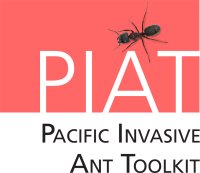Tawny crazy ant
|
harms crops |
harms people |
harms wildlife |
lives on ground |
day active |
Scientific name: Nylanderia fulva, formerly Paratrechina fulva, often mistakenly identified as Nylanderia pubens in the literature
Other common names: Rasberry crazy ant (named for the exterminator who first identified the invasion, Tom Rasberry)
Size: 3.2 mm
Colour: light to medium reddish brown.
|
Tawny crazy ant worker (© Mike Quinn, TexasEnto.net, Creative Commons License) |
Tawny crazy ants swarming on a passionvine fruit (© Mike Quinn, TexasEnto.net, Creative Commons License) |
General description: this ant appears rather dull due to the dense coat of fine hairs covering it. Compared to other crazy ants it has relatively short legs and appears squat, but like them it is characterized by frantic, erratic movement.
Habitat and nesting: the biology of the tawny crazy ant is not well known. Nests have been found under rocks, timber and in piles of debris.
Rate of spread: 200 m/year in Texas.
Distribution: see our invasive ant distributions page for the worldwide distribution of the tawny crazy ant.
Reproduction: no information found.
For detailed descriptions and identification of tawny crazy ants:
Social, agricultural and environmental impacts of the tawny crazy ant
The tawny crazy ant is a relatively new pest and is having a significant negative impact on people's lives where it occurs. A supercolony of this ant can reach numbers in the millions and often nests in and around homes. Here they cause misery by constantly running all over people and pets and getting into food and electronics. They appear to be attracted to electronic items and are notorious for shorting out things like televisions, circuit breakers, computers, air conditioners and vehicles. There have been reports of the tawny crazy ant killing chickens by blocking their nasal cavities and smothering them. It would be a disaster if this ant became established in the Pacific.
Information sources
AntWiki, Tawny crazy ant
Global Invasive Species Database (GISD) (mistakenly referred to as Nylanderia pubens)
Live Science, Tawny crazy ant, Nylanderia fulva
New York Times Magazine, Tawny crazy ant, Nylanderia fulva
Texas A & M University webpage, Tawny crazy ant, Nylanderia fulva
Content reviewed by Eli Sarnat, Antwork Consulting, LLC, June 2017


